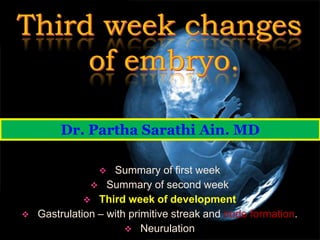The third week of embryonic development is characterized by gastrulation and the formation of the three germ layers. The most important event is the appearance of the primitive streak, which marks the beginning of gastrulation. During gastrulation, cells from the epiblast migrate through the primitive streak to form the endoderm and mesoderm, while those remaining form the ectoderm. This conversion of the bilaminar disc into a trilaminar disc containing three germ layers by the end of the third week is a significant developmental milestone.
























































































